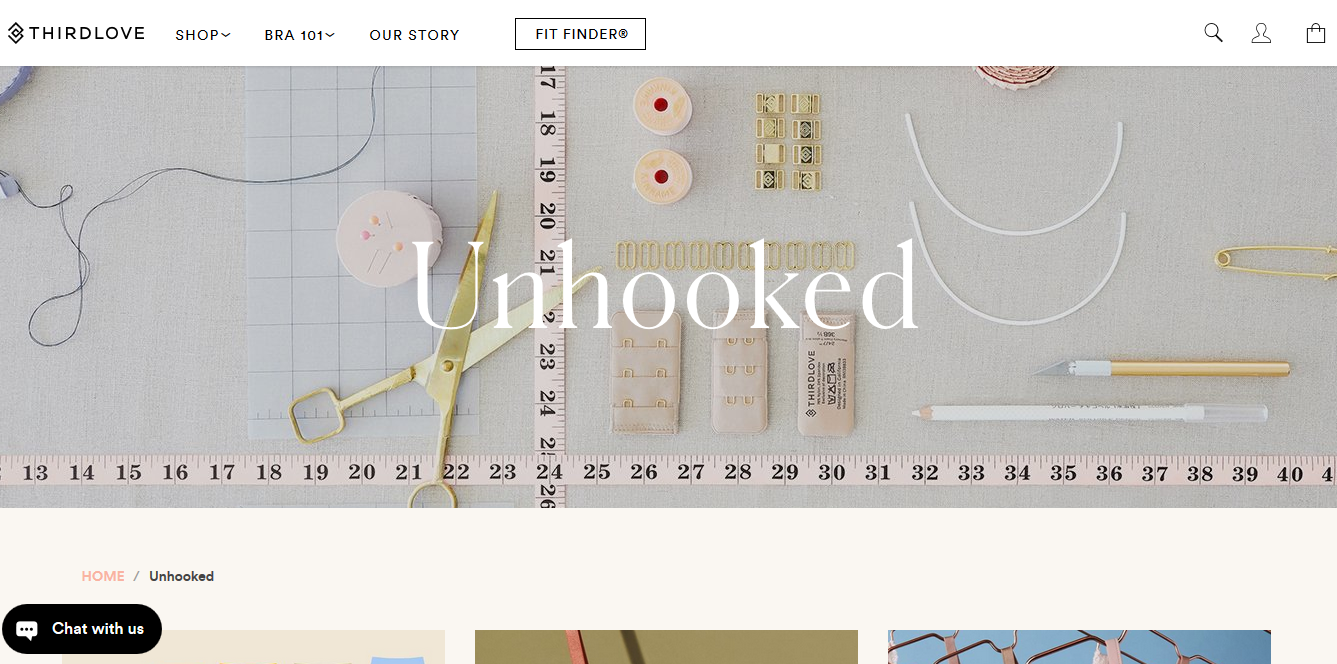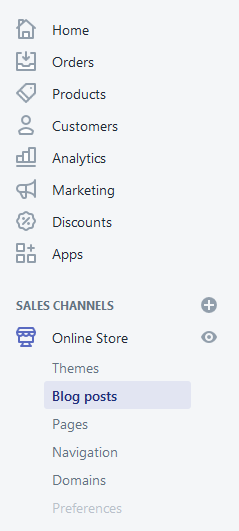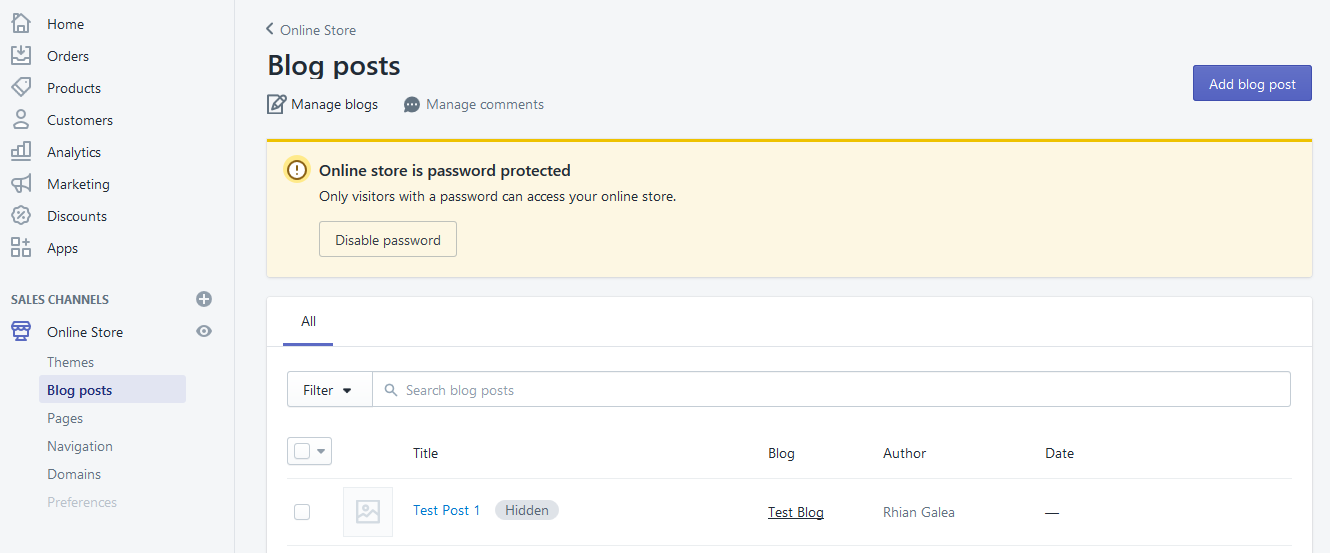How To Add A Blog To Shopify
The Digital Landscape
In a digital landscape awash with consumer choice, content marketing is leading the way in creating relationships between brand and audience. It was estimated in 2017 that by 2021 the content marketing industry would be worth more than $400 billion [2].

Alongside social media and email, blogging is one of the top 3 most utilised content marketing tactics [1],. Adding relevant and valuable blog content to your website is a powerful tool to drive sales and brand reputation by attracting a qualified audience and building a rapport with them.
Starting a blog on your store is very easy using Shopify's own free, in-house blogging tool. It integrates very simply into your store and the intuitive user dashboard makes creating your blog a piece of cake.
In this article we'll take a look at:
- The impact of blogging on Shopify
- Shopify v other blogging platforms
- SEO benefits
- Capabilities of the Shopify blog
- How to use Shopify blogs
- Using multiple blogs
- Shopify apps to make your blog even better
The impact of blogging on Shopify
Adding a blog to your Shopify store helps build an audience-powered business by creating awareness, adding value and richness to your website and building trust in your brand.
A blog will also help you gain traffic from social media. If you have valuable, interesting content the readers you attract through organic searches will be more likely to share it on their social media accounts, expanding your reach and bringing new visitors directly to your store.

Take, for example, the ThirdLove website which had around 1.74 million visitors in the first 6 months of 2019. 38.57% of their traffic is from search, of which 79.42% is organic, and 9.7% is from social [10].
They've built an extensive blog full of useful and interesting articles around the subject of underwear, adding a heap of value to their website.
Shopify versus Other Blogging Platforms
The Shopify blog is less sophisticated than some other popular blogging platforms, such as Wordpress, Blogger, Tumblr or Medium, but it covers all the blogging basics. We'll get into it's capabilities and how to use it later on.
The biggest benefit of blogging on Shopify is that you don't have to put much effort into integrating your blog with your store. Just add your blog to the menu and you're done. No plug-ins or linking required.
Having your store and blog on a single platform makes it much easier for you to manage too. One platform to maintain, one dashboard to get used to and features and apps that make it easy to use posts to promote your store.
There are, of course, drawbacks and you will need to assess your blogging requirements and ambitions to decide which platform to use. A dedicated blogging platform like Wordpress is arguably better if you are looking to create an extensive and complex blog.
Factors to consider include:
- Templates - the choice of templates in Shopify is much smaller than in other platforms and you can't build your own.
- Customization - if you have some coding knowledge (or a professional on hand who does) you can customize your template to suit your needs. Wordpress, on the other hand, has a much greater level of flexibility in this respect. Being open-source means that you can, with the right skills, create your own templates and adapt the pre-existing ones extensively.

- Content management - Shopify's blog includes tags and you can choose your own but the added categories and archive functions available in other blogs can make managing your content easier. If you're planning a fairly simple blog structure this probably won't be an issue for you but it's worth bearing in mind.
- Control over your content - because Shopify is SaaS (Software as a Service) hosted on their servers you need to be aware that Shopify could remove your content if it contravenes their terms of service. This will apply to some other blogging platforms too but Wordpress can be self-hosted with a provider of your choice. You also can't export your Shopify blog content so easily if you choose to change platform later on, a function many other blogging platforms do provide. You can however add an app to facilitate back-ups and exporting. Some apps you can use for this are "Rewind" and "Retrieve".
- Maintenance and security - the technical side of this is all provided as part of the service with Shopify, they will look after it all for you. This mostly applies to other hosted blogs too. With a self-hosted Wordpress blog though, it will be down to you (or your developer) to keep on top of software updates, security and back-ups.
- Support - part of the Shopify service is support and, depending on your package, that includes live chat, email and phone. This goes far beyond the support offered by most other blogging platforms and certainly Wordpress. Wordpress has a great community and support forum and many plug-in providers will offer support for their plug-ins but ultimately it will be down to you to resolve any issues.
- Clean URLs - Shopify prefixes all of it's blogs with "/posts/". Whilst this isn't a big problem, Wordpress definitely comes out better on this front with much greater control over your URLs which helps with SEO.
And on the subject of SEO here's another benefit of using Shopify's blog over other platforms. Once a visitor is reading your blog they're on your store. You'll have only one domain. Which brings us neatly on to…
SEO benefits
Adding a blog to your Shopify store benefits your SEO in several ways:
- Trust - Having your blog on the same domain as your store makes it easier to build trust on search engines. Every page on your domain contributes to trust. The quality of links and content are considered important elements when calculating domain trust and a high trust metric is a ranking advantage in search. If your blog posts become popular your domain gains trust. If your blog is hosted on a different platform that trust isn't transferred to your store.
- Increased keyword opportunities - Very simply, more content gives you the opportunity to get more keywords onto your website giving your search a boost.

- Google prefers substantial, quality content - In depth and topically relevant content improves search engine rankings. So do long-form articles so adding substantial, informative blog posts that are relevant to your products will help your search rankings.
- Good content keeps users on the page longer - Great blog content will keep users engaged and on your pages for longer, reducing your bounce rate. Bounce rate is, in a nutshell, the percentage of users that click onto your website then click back to their search results without spending a significant amount of time on your page. Search engines use this as a measure of the relevance your page has to the search term that was used.
- Backlinks - Good blog content will help gain links to your site from other websites, blogs and social media sites. Search engines use the number of backlinks your site has in their ranking algorithms.
Ultimately, blogging on your Shopify store should help bring in more qualified traffic. Now you know why you should be doing it so let's move on to the how.
Capabilities of the Shopify Blog
The Shopify blogging platform may be less comprehensive than some others but it still contains all the tools you need to create an effective blog. An easy to use text editor that allows you to create headings and format your text very simply also contains tools to insert images, video, links and tables.
The ability to schedule posts for future publication is particularly useful in allowing you to easily drip-feed content to your published blog or back-date posts. As with any good blog you can allow readers to leave comments and you can choose whether comments should be allowed automatically or moderated before publishing.
Alongside automatic SEO for the title and description, Shopify gives you the ability to customize your SEO features and the excerpt that's shown on the main blog page. You can add a featured image to appear on the blog page and tags to help with searches and filtering.
You can expand the range of features using add-on apps too. The Au Lit Fine Linens blog uses tags combined with an app to great effect allowing readers to filter their blog posts by topic. We'll look at apps in greater detail later.

How to Use Shopify Blogs
When you log in to your Shopify dashboard you'll find the "Blog posts" option under the Online Shop section of the menu on the right hand side. If you can't see it click on "Online Shop" to expand the full menu underneath.

First create your blog (posts come later):
- Click Manage blogs near the top of the main page area.

- A new section will open, click the Add Blog button on the right hand side of the screen.
- Give your blog a title.

- Choose if you want to integrate your blog with Feedburner, a third-party service that delivers a feed of your blog content to subscribers.
- On the right hand side choose how you would like to handle comments on your blog posts. You can change this later if you wish.
- If you want to manage the way search engines display your blog click the "Edit website SEO" link.
- Add the title, description and URL you'd like to be displayed in search engine listings.
- To finish creating your blog click the Save blog button in the bottom right-hand corner.
You can now create blog posts:
- On the main Blog posts page click the Add blog post button.

- In the blog editor give your post a title.
- Add your blog content to the text editor using the available tools to help you with formatting.

- If you have some HTML knowledge the text editor allows you to view and edit the HTML by clicking the " <> " button.
- You can add images and videos to the main content but if you want to add a featured image to your blog post click the Upload Image button in the Featured Image box on the right hand side.
- Your main blog listing page (and anywhere else you choose to feature a blog post on your Shopify store) will display a short section from the start of your content but if you want to control what will be shown in this excerpt click the Add Excerpt link in the box below the main content. Enter the text you'd like to be used.
- If you'd like to control how search engines will display the post click the Edit website SEO link and enter the title, description and URL you'd like search engines to display.

- On the right hand side assign the post to an author and choose which blog the post should belong to if you have more than one (we'll get onto multiple blogs later).
- Assign the post any tags you'd like to use. You can choose from the list of pre-existing tags or just type a new one in the box.
- Finally, near the top right hand side of the page select whether to publish your post now or later. Selecting Visible will publish immediately or selecting Hidden will keep it as an unpublished draft. Alternatively click the "Set a specific publish date" link to choose a date to publish it automatically.
- When you're done click the Save button. You can come back to your post later provided you have clicked Save.
Now you have a blog and a post you can add it to your website:
- In the right hand menu click Navigation.
- Select the menu you want to add your blog to.
- Click the Add Menu Item button.
- In the box that appears click in the link box and select your blog from the list that appears.

- In the Name box give the menu item a name. It will default to whatever your blog is called.
- Click the Add button then save your menu. Your blog is now visible on your website.
Top Tips
- Tags can be useful for searches and for sorting and categorizing your posts so use something appropriately descriptive.
- Name your blog something interesting, relevant and attention catching, it's much more likely to get traffic then if you just name it "Blog".
- Although Shopify blogs have automatic SEO features built in use the dedicated SEO tool to make sure your keywords are included.
- Include a link in your content that allows viewers to subscribe to the blog's RSS feed. They'll then be notified every time you publish a new post.
Using Multiple Blogs
Shopify's blogging tool allows you to create more than one blog. This allows you to create posts and assign them to blogs covering different topics.
The Sole Bicycles website is a good example of this. It has 2 blogs linked through separate menu items, one for general news and one specifically for press releases.

Using multiple blogs allows you to create more targeted content pages and increase your value and appeal to your customers.
Shopify apps to make your blog even better
Within the Shopify themes you'll find a number of features, like social media sharing buttons, but not all themes are the same. Fear not, if the feature you want isn't included in your chosen theme there's probably an add-on app that will do it for you.
There are literally 1000s of apps available but here are a few that you might like to check out:
- BlogFeeder - for importing blog content into Shopify from other blogs, either as a one-off or on an ongoing basis if you want to continue blogging on another platform.

- Kit - uses AI to market your posts and products on Facebook and Instagram for you, creating posts and identifying audiences.

- Benchmark Hero (SEO) - dive deeper into the SEO for your posts (and pages) with a more detailed analysis of your site.

- Related Blog Posts - does what it says on the tin, displays links to related posts.

- Easy Disqus - creates a link between Disqus (an online discussion tool add-on) and Shopify making an SEO friendly and more effective integration than the native Disqus code. Useful if you want a comprehensive and trusted discussion add-on to build a community.

- Shogun Page Builder - drag and drop page builder that you can use for pages and blog posts to really get creative with your layouts.

- Blog linker - automatically create links between your products and blog posts based on tags or randomly.

Of course if your theme doesn't include social sharing buttons you'll probably want to add an app to facilitate this too.

In conclusion, blogging on Shopify is simple to implement and potentially very beneficial to your business. Unless you're planning on a highly complex blog structure, a completely custom design or including potentially contentious content, (in which case you might have good reason to consider using Wordpress instead), it makes a great deal of sense to use the integrated Shopify blog. With the ability to customize it with a little coding or an add-on app it will perform most of the functions you're likely to need. Using the in-house Shopify blog will make life easier with no technical stuff to manage, only one dashboard to master and great support available. It will also boost your store's SEO through being on the same domain as your store.
References
[1] https://contentmarketinginstitute.com/wp-content/uploads/2017/09/2018-b2b-research-final.pdf
[2] https://www.forbes.com/sites/johnhall/2018/10/14/5-content-marketing-trends-to-watch-in-2019/#9d1228c1202c
[3] https://www.webfx.com/content-marketing/content-marketing-improve-SEO.html
[4] https://www.forbes.com/sites/forbesagencycouncil/2018/07/03/how-seo-and-content-marketing-work-together-to-fuel-your-online-success/#4b25096416bf
[5] https://www.stylefactoryproductions.com/blog/shopify-vs-wordpress
[6] https://www.stylefactoryproductions.com/blog/shopify-seo
[7] https://www.searchmetrics.com/glossary/domain-trust/
[8] https://backlinko.com/search-engine-ranking
[9] https://www.seohermit.com/articles/what-bounce-rate-means-for-your-seo-strategy/
[10] https://www.similarweb.com/website/thirdlove.com#overview
How To Add A Blog To Shopify
Source: https://www.devisedlabs.com/blog/how-to-use-shopify-blog-to-grow-your-brand
Posted by: martinhaddince.blogspot.com

0 Response to "How To Add A Blog To Shopify"
Post a Comment